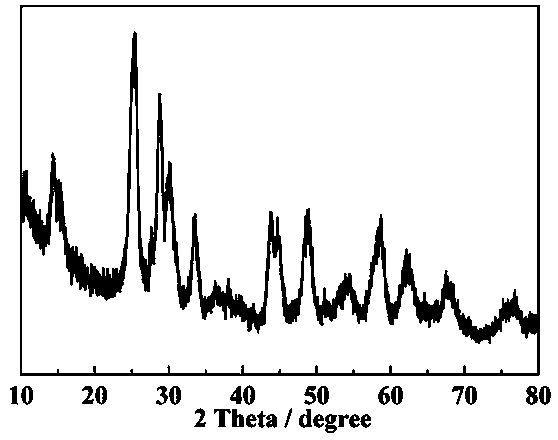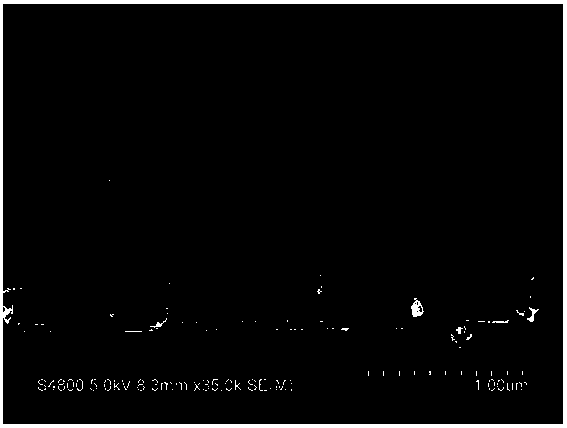An application of a rapidly synthesized B-phase titanium dioxide in a perovskite solar cell
A technology of solar cells and titanium dioxide, applied in the field of solar cells, can solve problems such as limited research, and achieve the effects of avoiding agglomeration, good reproducibility, and high efficiency
- Summary
- Abstract
- Description
- Claims
- Application Information
AI Technical Summary
Problems solved by technology
Method used
Image
Examples
Embodiment 1
[0016] A kind of application of rapidly synthesized B-phase titanium dioxide in perovskite solar cells, comprising the following steps:
[0017] (1) Take 60 mL of deionized water and place it in a 100 mL beaker, add 7 g of glycolic acid solid and 4 g of urea in sequence, and stir for 15 min. After it is fully dissolved, measure 2.0 mL of tetrabutyl titanate solution with a pipette gun, add it dropwise into the beaker, and stir vigorously for 5 min. Subsequently, measure 0.4 mL of concentrated sulfuric acid liquid with a pipette gun, slowly add it to the above solution, and continue to stir vigorously for 15 min. The solution in the beaker was transferred to a 100 mL autoclave, and placed in an oven at 180 °C for 3 h at constant temperature to obtain a gray precipitate. The gray precipitate was centrifuged, washed three times with deionized water, and dried to obtain a B-phase titanium dioxide precursor.
[0018] (2) Mix the prepared B-phase titanium dioxide precursor with et...
Embodiment 2
[0021] A kind of application of rapidly synthesized B-phase titanium dioxide in perovskite solar cells, comprising the following steps:
[0022] (1) Take 50mL of deionized water and place it in a 100mL beaker, add 6g of glycolic acid solid and 3g of urea in sequence, and stir for 15 min. After it was fully dissolved, measure 1.5 mL tetrabutyl titanate solution with a pipette gun, add it dropwise into the beaker, and stir vigorously for 5 min. Subsequently, measure 0.3 mL of concentrated sulfuric acid liquid with a pipette gun, slowly add it to the above solution, and continue to stir vigorously for 15 min. The solution in the beaker was transferred to a 100 mL autoclave, and placed in an oven at 170 °C for 2 h at constant temperature to obtain a gray precipitate. The gray precipitate was centrifuged, washed three times with deionized water, and dried to obtain a B-phase titanium dioxide precursor.
[0023] (2) Mix the prepared B-phase titanium dioxide precursor with ethyl ce...
Embodiment 3
[0025] A kind of application of rapidly synthesized B-phase titanium dioxide in perovskite solar cells, comprising the following steps:
[0026] (1) Take 70 mL of deionized water and put it in a 100 mL beaker, add 8 g of glycolic acid solid and 5 g of urea in sequence, and stir for 15 min. After it was fully dissolved, measure 2.5 mL tetrabutyl titanate solution with a pipette gun, add it dropwise into the beaker, and stir vigorously for 5 min. Subsequently, measure 0.5 mL of concentrated sulfuric acid liquid with a pipette gun, slowly add it to the above solution, and continue to stir vigorously for 15 min. The solution in the beaker was transferred to a 100 mL autoclave, and placed in an oven at 200 °C for 4 h at constant temperature to obtain a gray precipitate. The gray precipitate was centrifuged, washed three times with deionized water, and dried to obtain a B-phase titanium dioxide precursor.
[0027](2) Mix the prepared B-phase titanium dioxide precursor with ethyl c...
PUM
| Property | Measurement | Unit |
|---|---|---|
| Thickness | aaaaa | aaaaa |
| Thickness | aaaaa | aaaaa |
Abstract
Description
Claims
Application Information
 Login to View More
Login to View More - R&D
- Intellectual Property
- Life Sciences
- Materials
- Tech Scout
- Unparalleled Data Quality
- Higher Quality Content
- 60% Fewer Hallucinations
Browse by: Latest US Patents, China's latest patents, Technical Efficacy Thesaurus, Application Domain, Technology Topic, Popular Technical Reports.
© 2025 PatSnap. All rights reserved.Legal|Privacy policy|Modern Slavery Act Transparency Statement|Sitemap|About US| Contact US: help@patsnap.com



